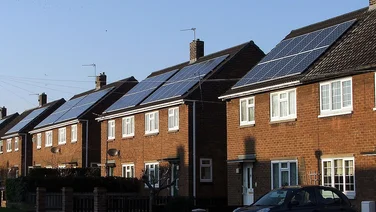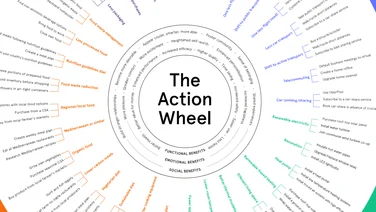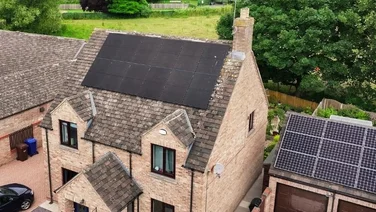- What’s on this page?
- Can you get paid to reduce your electricity usage at home?
- Who is offering the incentive?
- How long will these schemes be available?
- What are the requirements for receiving these payments?
- Why are some companies paying households to cut their energy use?
- Could this be a permanent benefit in the future?
- Summary
✔ The Demand Flexibility Service has been created to combat blackouts
✔ Customers will be encouraged to reduce energy consumption at peak times
✔ Only customers with a smart meter will be eligible for the scheme
As surreal as it sounds, the UK could be facing blackouts this winter.
John Pettigrew, Chief Executive of the National Grid has warned British households that blackouts may be imposed between 4pm and 7pm on “those deepest, darkest evenings in January and February”.
To combat this energy shortage issue, various companies – including British Gas, E.ON, EDF, Octopus, Ovo, Shell Energy, and Utilita – have teamed up with the National Grid to encourage customers to use energy at off-peak times.
Although each supplier will offer a different service, the scheme will pay users to cut back on energy use.
Sound like something you want to get involved with? Check out the requirements further below.

What’s on this page?
Can you get paid to reduce your electricity usage at home?
Yes, from November 2022 to March 2023, some UK homeowners will receive payments for reducing their electricity consumption at home.
This has been made possible through the Demand Flexibility Service (DFS) – a scheme created by the National Grid Electricity System Operator (ESO) to encourage consumers to reduce their power consumption at certain times.
If the scheme is successful, it could prevent the UK from having to dip into its emergency electricity supplies – and even avoid blackouts.
How does the Demand Flexibility Service (DFS) work?
The DFS scheme has partnered with energy suppliers and companies around the UK to offer users payments if they successfully reduce their energy consumption during certain timeframes.
The National Grid is keen to point out that customers won’t need to cut off all power during these times, just reduce the amount of energy they use. And the more they reduce, the more they get paid.
The scheme can be broken down into five simple steps:
- Energy supplier signs up for the DFS
- The supplier gets in touch with customers about the scheme
- Eligible customers sign up if they want to get involved
- The supplier sends an alert out to customers 24 hours before the ‘test’ (times when customers should reduce power consumption) begins
- Customers will receive payment for the amount of energy they reduced
DFS tests should last for roughly one hour and will take place during weekdays – when demand for electricity is at its highest. However, the ESO has suggested that these tests could last up to 3-4 hours if needed.
Customers can expect a maximum of 12 tests between November and March 2023.
Although the exact details of the scheme will vary, depending on which energy supplier the customer is accessing it through, tests will have a guaranteed minimum price of £3 per kWh – meaning a typical household could save about £100 over the course of winter 2022/2023 (if they participate in every test).
Users can choose to have this money through credit on their energy account or by having it directly transferred to their bank account.
If you register to take part in the DFS but later decide you don’t want to, don’t worry, there aren’t any penalties for not participating once you have signed up – you just won’t receive any payments.
Who is offering the incentive?
There are a number of energy suppliers and companies that are offering the DFS – although, confusingly, they’re sometimes called different things.
According to the ESO, the suppliers and companies that have been approved to roll out a scheme include:
- British Gas (scheme called Peak Save)
- CarbonLaces
- Conrad Energy
- CUB (UK) Ltd (scheme called Demand-Side Response)
- Drax
- ENGIE Power Limited (scheme called Demand-Side Response)
- E.ON Next – (scheme called Energy Shift)
- Equiwatt
- Ev.energy
- Flexitricity
- Grid Beyond
- Gridimp
- Hugo Energy App
- Labrador (scheme called Peak Payments)
- Loop.homes (scheme called Turn Down and Save)
- myenergi (scheme called Flexibility Beta)
- Oaktree Power
- Octopus Energy (scheme called Octopus Saving Sessions)
- Pearlstone Energy (scheme called Demand Side Response)
- Power Rewards App
- Shell Energy Retail
- SMS
- VpowerU
- Zenobe Energy Limited
These suppliers can provide the scheme to customers who have a smart meter, and their prices will be based on the ESO’s rate of £3 per kWh. Although a typical household could save around £100, each energy provider will also have additional incentives for their campaigns, so there could be more up for grabs.
How long will these schemes be available?
The scheme will be running from 1 November 2022 to 31 March 2023, since the main goal of the DFS is to prevent the UK from having blackouts during the winter.
What are the requirements for receiving these payments?
Generally, to receive payments for the DFS scheme, applicants must:
- Be a customer of the energy supplier/company – Energy suppliers and companies are only offering this scheme to customers that are registered with them
- Have a smart meter – Most energy suppliers will only onboard you to the scheme if they’re able to take half-hourly readings of your energy consumption through a smart meter. This way, they can guarantee that the readings are as accurate as possible
- Reduce energy consumption during each test event – Four tests will take place in the first full month that the customer is signed up, followed by two tests each subsequent month. During these times, customers should reduce the amount of energy they consume at home. If they fail to do so, they won’t receive the payment
However, bear in mind that the eligibility criteria for the DFS is different for each energy supplier rolling out the scheme. For example, whilst EDF states its scheme will only be available for a small group of customers with smart meters, Octopus Energy will be offering it to nearly all of its 1.4 million customers who have smart meters.
All eligible customers will receive an email, inviting them to sign up for the scheme. Once signed up, you’ll need to provide your supplier access to your smart meter, so they can read your data every half-hour from 1 November 2022 to 31 March 2023.
Eligible customers should have heard from their energy supplier about this by late October/November – so if you think you’re eligible but haven’t heard about the scheme, it’s worth chasing up your supplier.
Why are some companies paying households to cut their energy use?
The ongoing energy crisis is putting a lot of strain on the UK’s energy supply. As a result, some experts are warning that the country could experience blackouts throughout winter.
To avoid this from happening, the National Grid has rolled out the DFS, which will reduce nationwide energy consumption, and prevent the chance of having to use emergency energy supplies.
The ESO states that “in times of system stress, when margins are tight, it could also help us avoid an emergency response.”
A key reason behind the energy crisis is Russia’s war in Ukraine, which has had a domino effect on the rest of the world. As countries continue to voice their support for Ukraine, Putin has repeatedly threatened to switch off the pipes permanently that transport gas supplies to European countries.
On top of this, the UK’s energy supply took a hit in 2021, after a fire at the Sellindge converter station in Kent meant it had to shut down a high-voltage cable that brings electricity from France.
Despite expressing concerns over the past few months, Chief Executive of the National Grid, John Pettigrew, has recently stated that Europe’s mild autumn should help us avoid the worst-case scenario:
“What we have seen is pretty mild weather, which has led the Europeans to probably put more gas into storage than they originally anticipated. My understanding is that the storage in Europe now is pretty much full.”
The ESO also claims that the DFS could be an important step to helping the UK reduce its carbon emissions by stating that reducing energy demand at certain times will mean, “we might not have to bring on expensive and polluting fossil fuel generators”.
Could this be a permanent benefit in the future?
Although nothing has been announced, introducing incentives for customers to consume more energy outside of peak hours could become more popular in the coming years – especially during the energy crisis.
The energy market is very uncertain at the moment. Not only are we transitioning from fossil fuels to renewable sources, but the war on Ukraine has also triggered energy shortages.
It’s these significant changes to the energy industry that encouraged the National Grid to start thinking about whether the concept for a demand flexibility service would actually work in the UK – leading to a trial with Octopus Energy in early 2022 to test just this.
The results of this trial were successful, and prompted the National Grid to team up with suppliers and consumer groups to create the DFS.
If this scheme proves to be successful, we could see this more commonly during winters in the future.
Summary
Seeing news of possible blackouts is not something we’re accustomed to in the UK.
Of course, in the long term, the government needs to address the reason behind energy shortages in the UK. The country needs to ramp up cheap renewable production and energy storage capacity, and it desperately needs to change the UK’s outdated energy system.
In the short term, the DFS could help make energy bills cheaper for households around the UK, whilst preventing the country from having blackouts during the winter.






